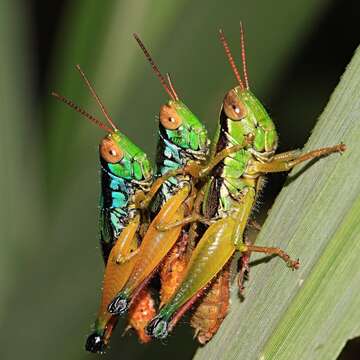Grasshoppers' - 3some -

Description:
2 male (blue tegmina) & 1 female (green tegmina) Grasshopperssat in harmony on this culm for hours; they hear with their first abdominal segment and use vibrations to locate each other.Even when they reach maturity wings are not fully developed so they can not fly. In the rice fields they are prey to dragonflies and the local communities also collect them to eat.Caryanda spuria STL, 1861Subfamily: OxyinaeFamiily: Acrididae (Feldheuschrecken)Superfamily: AcridoideaInfraorder: AcridideaSuborder: Caelifera ANDER, 1939 (short-horned grasshopper, Kurzfhlerschrecken)Order: Orthoptera (Springschrecken)Subclass: PterygotaClass: Insecta (insects, Insekten)Subphylum: HexapodaPhylum: Arthropodataxonomical info: orthoptera.speciesfile.org/Common/basic/Taxa.aspx?TaxonNa...Indonesia, W-Java, 33km WNW Bogor (Mt. Halimun-Salak-NP): vic. Cipeteuy (at the edge of paddy fields), ca. 1100m asl., 21.09.2010*Description: ~2cm, yellow body with black bands, yellow legs and blue-green knees. The upper-side of is green and the tegmina (hardened fore-wings) are blue-metallic while show a brown upper-side and tegmina are green.*Distribution: Java. The Genus Caryanda is widely distributed in the tropics and subtropics of the old world.*Habitat: commonly found in grasslands, in open areas and paths in the forest and in farmland (mainly paddy), 0-1200m asl._______________________________________________100mm 2.8 macro (Canon, L): 1/125s, f13, ISO100, 0 EV, built-in flash, hand-held(IMG_9130)
Included On The Following Pages:
- Life (creatures)
- Cellular (cellular organisms)
- Eukaryota (eukaryotes)
- Opisthokonta (opisthokonts)
- Metazoa (Animal)
- Bilateria
- Protostomia (protostomes)
- Ecdysozoa (ecdysozoans)
- Arthropoda (arthropods)
- Pancrustacea
- Hexapoda (hexapods)
- Insecta (insects)
- Pterygota (winged insects)
- Neoptera (neopteran)
- Polyneoptera
- Orthopterida
- Orthoptera (grasshoppers and relatives)
- Caelifera
- Acridoidea
- Acrididae (short-horned grasshoppers)
- Caryanda
- Caryanda spuria
This image is not featured in any collections.
Source Information
- license
- cc-by-sa-2.0
- copyright
- gbohne
- photographer
- gbohne
- original
- original media file
- visit source
- partner site
- Flickr Group
- ID


